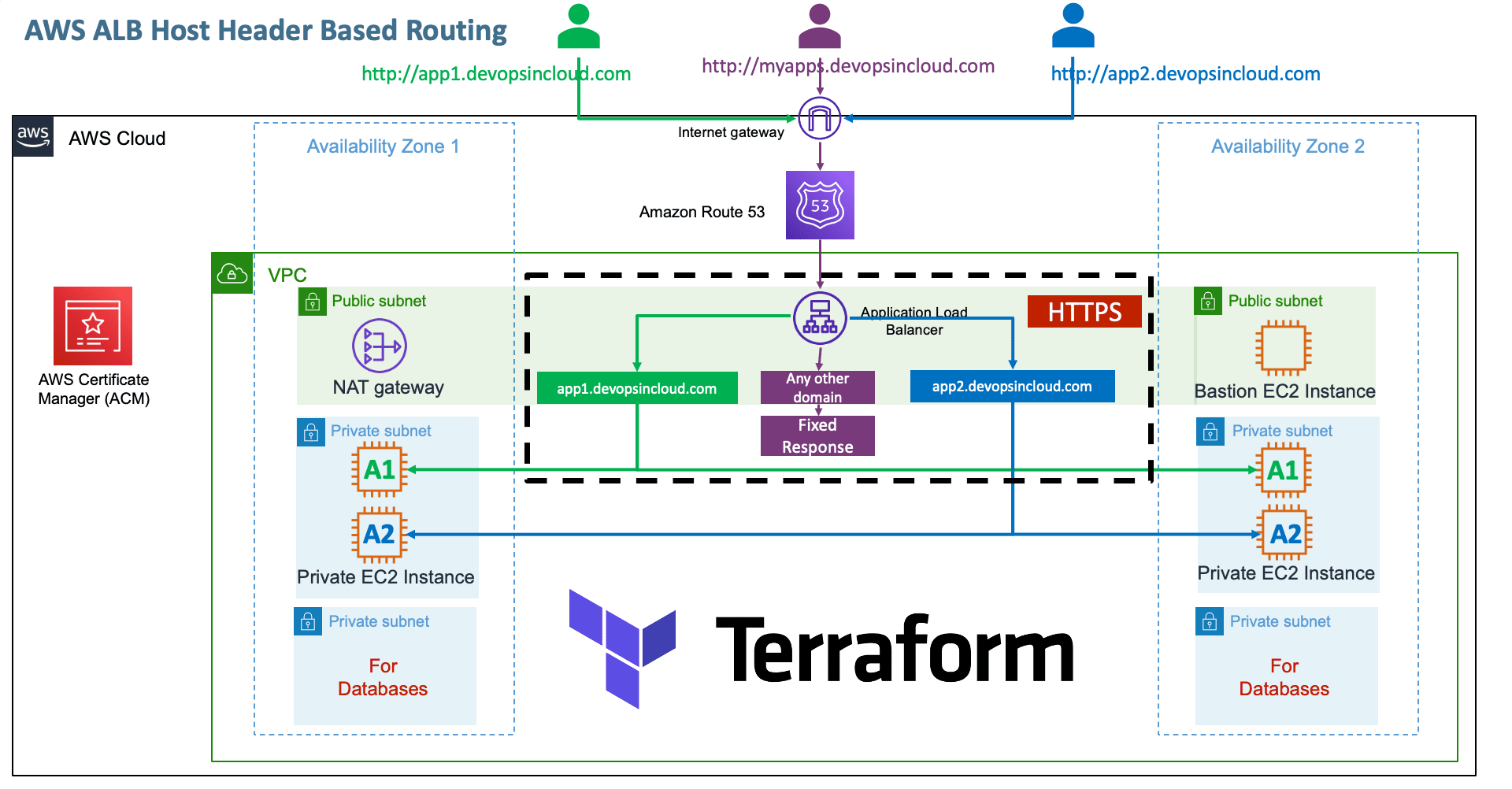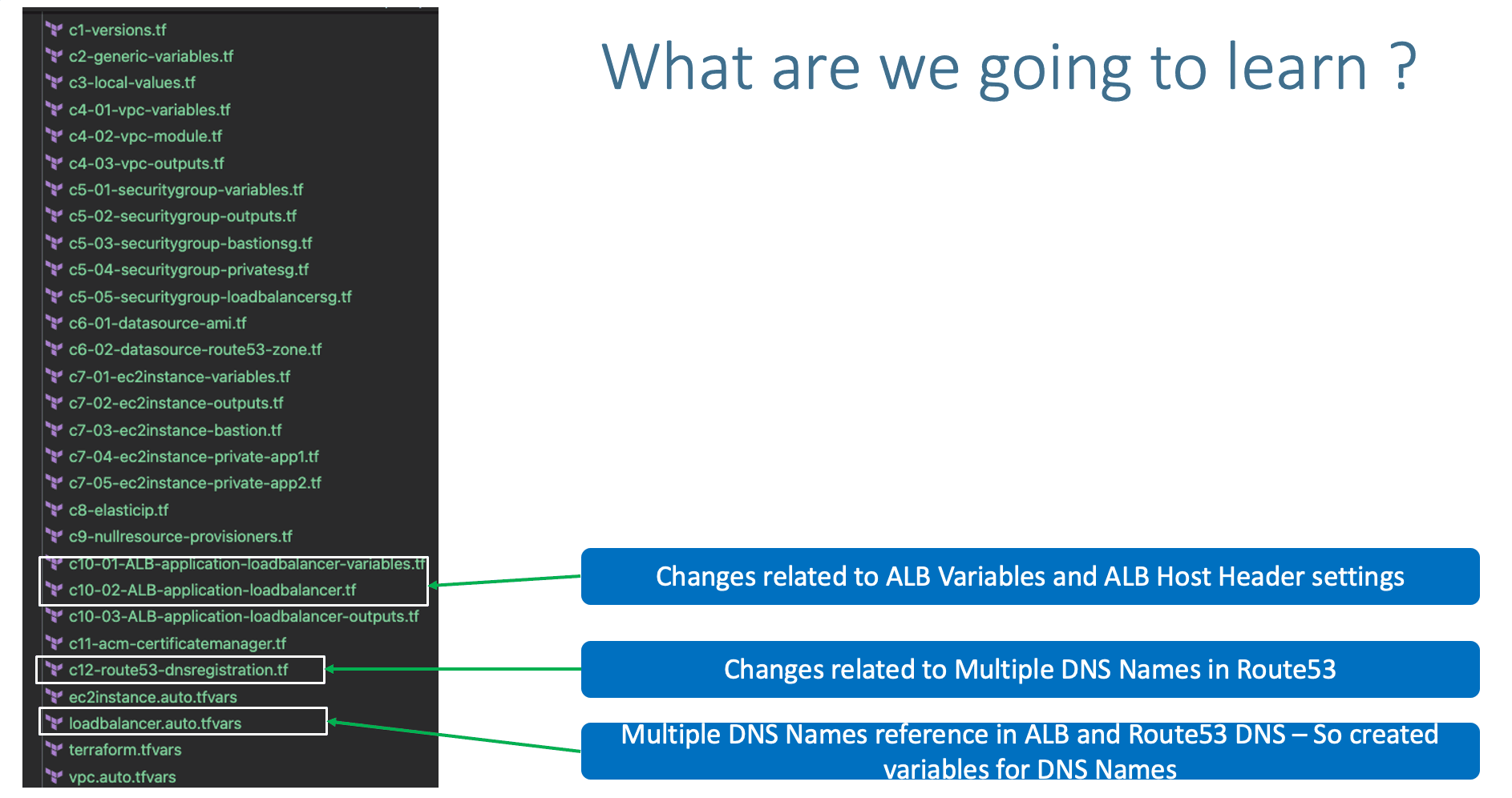| title | description |
|---|---|
AWS ALB Host Header based Routing using Terraform |
Create AWS Application Load Balancer Host Header based Routing Rules usign Terraform |
- You need a Registered Domain in AWS Route53 to implement this usecase
- Copy your
terraform-key.pemfile toterraform-manifests/private-keyfolder
- Implement AWS ALB Host Header based Routing
- Review the AWS Support Case ID 8245155801 to demonstrate the issue and resolution from AWS
- Understand about how to submit the case related to Limit Increase for ACM Certificates.
- It will take 2 to 3 days to increase the limit and resolve the issue from AWS Side so if you want to ensure that before you hit the limit, if you want to increase you can submit the ticket well in advance.
Error: Error requesting certificate: LimitExceededException: Error: you have reached your limit of 20 certificates in the last year.
on .terraform/modules/acm/main.tf line 11, in resource "aws_acm_certificate" "this":
11: resource "aws_acm_certificate" "this" {- Option-1: Submit the ticket to AWS and wait till they update the ACM certificate limit
- Option-2: Switch to other region and continue with our course.
- This limit you can hit at any point during your next sections of the course where you exceeded 20 times of certificate creation and deletion.
- With that said knowing to run these Terraform Manifests in other region is a better option.
- I will show you the steps you can perform to switch the region using the terraform manifests if you face this issue.
- Use this folder
terraform-manifests-us-east-2terraform manifests to create resources in us-east-2 region. - Review
step-04for changes we need to perform to switch regions.
# Before
aws_region = "us-east-1"
# After
aws_region = "us-east-2"# Before
vpc_availability_zones = ["us-east-1a", "us-east-1b"]
# After
vpc_availability_zones = ["us-east-2a", "us-east-2b"]- Go to Services -> EC2 -> Network & Security -> Keypairs
- Name: terraform-key-us-east-2
- File Format: pem
- Click on Create keypair
- You can have the keypair name same in us-east-2 region also so that you don't need to change anything in
c9-nullresource-provisioners.tf. Choice is yours. - To identify the difference, i have given different name here.
- Copy the newly created keypair
terraform-key-us-east-2.pemtoterraform-manifests\private-keyfolder
# KeyPair Permissions
cd terraform-manifests\private-key
chmod 400 terraform-key-us-east-2.pem
# Before
instance_keypair = "terraform-key"
# After
#instance_keypair = "terraform-key"
instance_keypair = "terraform-key-us-east-2"# Create a Null Resource and Provisioners
resource "null_resource" "name" {
depends_on = [module.ec2_public]
# Connection Block for Provisioners to connect to EC2 Instance
connection {
type = "ssh"
host = aws_eip.bastion_eip.public_ip
user = "ec2-user"
password = ""
private_key = file("private-key/terraform-key-us-east-2.pem")
}
## File Provisioner: Copies the terraform-key.pem file to /tmp/terraform-key-us-east-2.pem
provisioner "file" {
source = "private-key/terraform-key-us-east-2.pem"
destination = "/tmp/terraform-key-us-east-2.pem"
}
## Remote Exec Provisioner: Using remote-exec provisioner fix the private key permissions on Bastion Host
provisioner "remote-exec" {
inline = [
"sudo chmod 400 /tmp/terraform-key-us-east-2.pem"
]
}
## Local Exec Provisioner: local-exec provisioner (Creation-Time Provisioner - Triggered during Create Resource)
provisioner "local-exec" {
command = "echo VPC created on `date` and VPC ID: ${module.vpc.vpc_id} >> creation-time-vpc-id.txt"
working_dir = "local-exec-output-files/"
#on_failure = continue
}- We will be using these variables in two places
- c10-02-ALB-application-loadbalancer.tf
- c12-route53-dnsregistration.tf
- If we are using the values in more than one place its good to variablize that value
# App1 DNS Name
variable "app1_dns_name" {
description = "App1 DNS Name"
}
# App2 DNS Name
variable "app2_dns_name" {
description = "App2 DNS Name"
}# AWS Load Balancer Variables
app1_dns_name = "app16.devopsincloud.com"
app2_dns_name = "app26.devopsincloud.com" conditions = [{
#path_patterns = ["/app1*"]
host_headers = [var.app1_dns_name]
}] conditions = [{
#path_patterns = ["/app2*"]
host_headers = [var.app2_dns_name]
}]## Default DNS
resource "aws_route53_record" "default_dns" {
zone_id = data.aws_route53_zone.mydomain.zone_id
name = "myapps.devopsincloud.com"
type = "A"
alias {
name = module.alb.this_lb_dns_name
zone_id = module.alb.this_lb_zone_id
evaluate_target_health = true
}
}
# DNS Registration
## App1 DNS
resource "aws_route53_record" "app1_dns" {
zone_id = data.aws_route53_zone.mydomain.zone_id
name = var.app1_dns_name
type = "A"
alias {
name = module.alb.this_lb_dns_name
zone_id = module.alb.this_lb_zone_id
evaluate_target_health = true
}
}## App2 DNS
resource "aws_route53_record" "app2_dns" {
zone_id = data.aws_route53_zone.mydomain.zone_id
name = var.app2_dns_name
type = "A"
alias {
name = module.alb.this_lb_dns_name
zone_id = module.alb.this_lb_zone_id
evaluate_target_health = true
}
}# Terraform Initialize
terraform init
# Terraform Validate
terraform validate
# Terraform Plan
terraform plan
# Terraform Apply
terraform apply -auto-approve
# Verify
Observation:
1. Verify EC2 Instances for App1
2. Verify EC2 Instances for App2
3. Verify Load Balancer SG - Primarily SSL 443 Rule
4. Verify ALB Listener - HTTP:80 - Should contain a redirect from HTTP to HTTPS
5. Verify ALB Listener - HTTPS:443 - Should contain 3 rules
5.1 Host Header app1.devopsincloud.com to app1-tg
5.2 Host Header app2.devopsincloud.com toto app2-tg
5.3 Fixed Response: any other errors or any other IP or valid DNS to this LB
6. Verify ALB Target Groups App1 and App2, Targets (should be healthy)
5. Verify SSL Certificate (Certificate Manager)
6. Verify Route53 DNS Record
# Test (Domain will be different for you based on your registered domain)
# Note: All the below URLS shoud redirect from HTTP to HTTPS
# App1
1. App1 Landing Page index.html at Root Context of App1: http://app1.devopsincloud.com
2. App1 /app1/index.html: http://app1.devopsincloud.com/app1/index.html
3. App1 /app1/metadata.html: http://app1.devopsincloud.com/app1/metadata.html
4. Failure Case: Access App2 Directory from App1 DNS: http://app1.devopsincloud.com/app2/index.html - Should return Directory not found 404
# App2
1. App2 Landing Page index.html at Root Context of App1: http://app2.devopsincloud.com
2. App1 /app2/index.html: http://app1.devopsincloud.com/app2/index.html
3. App1 /app2/metadata.html: http://app1.devopsincloud.com/app2/metadata.html
4. Failure Case: Access App2 Directory from App1 DNS: http://app2.devopsincloud.com/app1/index.html - Should return Directory not found 404# Terraform Destroy
terraform destroy -auto-approve
# Delete files
rm -rf .terraform*
rm -rf terraform.tfstate*
